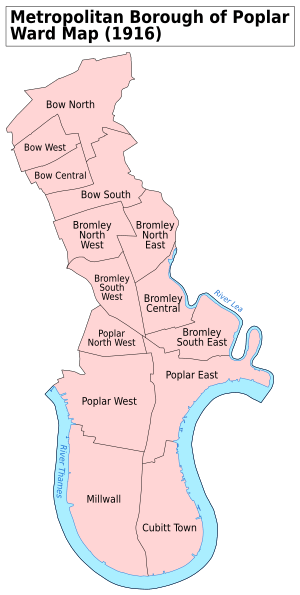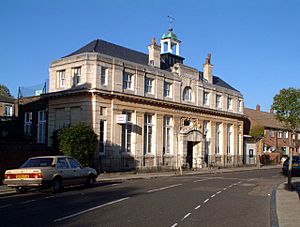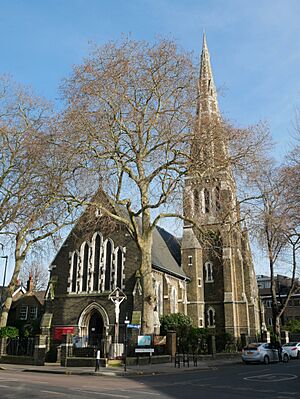Cubitt Town facts for kids
Quick facts for kids Cubitt Town |
|
|---|---|
 Manchester Road. |
|
| OS grid reference | TQ385795 |
| London borough | |
| Ceremonial county | Greater London |
| Region | |
| Country | England |
| Sovereign state | United Kingdom |
| Post town | LONDON |
| Postcode district | E14 |
| Dialling code | 020 |
| Police | Metropolitan |
| Fire | London |
| Ambulance | London |
| EU Parliament | London |
| UK Parliament |
|
| London Assembly | |
Cubitt Town is a neighborhood located on the eastern side of the Isle of Dogs in London, England. It's named after William Cubitt, who was a very important person in London's government (the Lord Mayor of London) from 1860 to 1862. He helped develop this area in the 1840s and 1850s.
Cubitt Town is on the east side of the Isle of Dogs. It faces the Royal Borough of Greenwich across the River Thames. To its west is Millwall, and to the east and south is Greenwich. Canary Wharf is to the northwest, and Blackwall is to the north. This area is part of the Blackwall & Cubitt Town Ward within the Tower Hamlets London Borough Council.
Contents
How Did Cubitt Town Start?
Cubitt Town gets its name from William Cubitt. He was the Lord Mayor of London from 1860 to 1862. William Cubitt was in charge of building homes and services in this area during the 1840s and 1850s. He did this mainly to provide housing for the many workers. These workers were employed in the local docks, shipbuilding yards, and factories. As the area grew, Cubitt also started many local businesses. These businesses hired manual laborers and built the streets of houses where they could live.
What Industries Were Here?
For many years, Cubitt Town was a hub for shipbuilding. Companies like Westwood, Baillie, Samuda Brothers, J & W Dudgeon, and Yarrow Shipbuilders were located here. An important warship, HMS Prince Albert, was launched here. It was the first British warship designed to carry its main guns in special rotating turrets.
Other businesses in Cubitt Town made things like cement, pottery, and bricks. Making asphalt was another growing industry. This happened as more areas across Britain were developed and became industrial. In Cubitt Town, a place called Pyrimont Wharf was built in 1861. It was used for asphalt production.
Where Do People Live?
Cubitt Town has several housing areas, including:
- New Union Wharf Estate
- Samuda Estate
- St John's Estate
- Amsterdam Road
- Millennium Wharf
The area is a mix of different communities. You'll find long-time working-class families from East London. Many now live in taller buildings built in the 1960s and 1970s. There are also people who work in the nearby Canary Wharf area. They are attracted by the good prices for homes near the river. Plus, there are communities of Bangladeshi and East Asian people who have moved here over time.
Learning and Education
A public library was built in Cubitt Town in 1905. It was paid for by a famous businessman named Andrew Carnegie. The architect who designed it was C. Harrold Norton. Will Crooks, who was the Mayor of Poplar at the time, met Carnegie. Carnegie had promised to pay for public libraries. Crooks managed to get him to agree to fund two libraries: one in Cubitt Town and another in Bromley by Bow. Carnegie gave £15,000 for both libraries together. The Cubitt Town library cost £6,805 13s 10d. This cost included some land next door that was first a public garden. Later, in 1962, it became space for an extension used as a meeting hall.
Today, the Tower Hamlets London Borough Council owns the building. It is still part of their library service.
Schools in Cubitt Town
Primary Schools
- Cubitt Town School
- St Luke's School
Fun and Recreation
Cubitt Town offers several places for fun and relaxation:
- St John's Park
- Mudchute, a large urban farm that covers about 32 acres.
Getting Around Cubitt Town
The closest train station to Cubitt Town is Crossharbour. This station is on the Docklands Light Railway, which opened on August 31, 1987.
Several London Buses routes serve Cubitt Town. These include routes 135, 277, D7, D8, and N550.
Cubitt Town is connected to London's main roads by Manchester Road. This road is part of the A1206.
You can also cross the River Thames from Cubitt Town using the Greenwich Foot Tunnel. This tunnel is also part of the National Cycle Route 1.
Nearby Places





